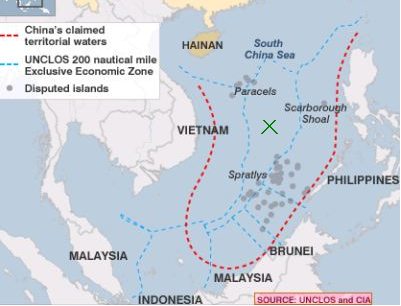“The United States has a national interest in freedom of navigation, open access to Asia’s maritime commons and respect for international law in the South China Sea…” US Secretary of State Hillary Clinton.
Not before time, Washington points out – without using these actual words – that the PRC’s apparent claims to the South China Sea are illegitimate. The longer this was left unsaid, the more confident Beijing would become that the world’s last remaining empire could assume sovereignty not only over Tibet and Xinjiang, but over stretches of open ocean too.
Since 1947, Mainland (and Taiwanese) maps of China have featured the famous ‘nine-dotted line’ that appears to show the country’s boundaries extending virtually all the way down to North Borneo. Under the UN Convention of the Law of the Sea, all nations with a coastline have territorial sovereignty up to 12 nautical miles offshore. However, even this is open for foreign ships to pass through en route elsewhere (including military vessels subject to certain conditions – eg, submarines must surface). This is why Hong Kong’s gambling cruises sail 12 miles south before opening the casinos: they leave the Big Lychee’s jurisdiction. Countries have an economic zone extending up to 200 miles, bestowing fishing and mineral rights. Countries also have some economic rights over up to a further 150 miles of continental shelf, if any.
This leaves plenty of room for disagreements. The blue dotted lines on the map below indicate what a fair-minded arbiter might decide, but most of the countries adjoining the South China Sea bicker about the exact extents, angles and curves of the boundaries. The empty bit with a green ‘X’ in the middle is beyond anyone’s 200-mile limit.
The red line is China’s ambitious-looking claim. Beijing officials have never specified exactly what it means, but they are adamant that the country has sovereignty over the Paracel (Xisha) and Spratley (Nansha) islet groups. All of them. The Republic of China made such a claim in 1932. Many of these reefs, atolls and rocky outcrops are not even above the sea surface at high tide, suggesting that they do not count as territory at all. Other countries in the region, especially Vietnam, also declare sovereignty over many of these tiny specks on the map, some of which host desolate military posts and other facilities from the different nations designed to bolster their respective cases.
China insists that history is on its side and points to ancient literature, maps and archaeological evidence like coins and pottery attesting to a vibrant Sinic culture on the specks dating back 2,000 years to the Han Dynasty, no less.
US policy up to now has been not to acknowledge that China has made any claim, and Clinton’s comments do not contradict this. But she does declare the issue to be a multilateral one, of international interest. China has always demanded that discussions on the issue be bilateral so it can intimidate places like Vietnam and the Philippines one by one. For example, Chinese authorities have arrested Filipino and other fishermen in disputed waters, and Beijing threatens US and other foreign oil companies considering joint-venture exploration agreements with the region’s smaller powers.
The territorial disputes among the South China Sea’s countries, several of which are investing in submarines to show they’re serious, are essentially about oil and gas, and to some extent potential control of strategic sea lanes. But from the US and international point of view the issue is also about registering displeasure with China’s weak handling of North Korea – hence the current US-South Korean naval exercises – and a long-overdue assertion that an increasingly uppity PRC is not going to make the South China Sea (‘maritime commons’) into its own lake. Beijing, and especially the military, will huff and puff about American hegemonists seeking to contain the motherland. Everyone else in Asia is breathing a sigh of relief.



This generous interpretation of Hillary’s political acumen begs the question of why the South China Sea is an essential security interest of the US. Well, I guess China is physically closer to the US than Afghanistan.
boo, of course this is motivated by US self-interest, but it’s less about neocon-style foreign policy and more about maintaining the global economy (vs the Chinese economy) as well as checking China’s growing sense of imperialistic entitlement. In this case, by pointing out that international law applies equally to everyone and implying that it is not ok for one country (however many systems) to stampede all over Asia wherever its sovereign, economic or cultural desires take it.
If only everyone’s favourite blog lurker were here to comment on Hemmy’s use of a CIA-sourced map.
“That’s alright. These things gotta happen every five years or so, ten years, helps get rid of the bad blood. Been ten years since the last one.”
Fastest way for the other countries to keep China out is to cede one speck each to Japan. They’ve the most advanced technology for turning tidal shallows into solid earth (Okinotorishima) and both Chinas’ track records on Diaoyutai—oh I mean Senkaku—speaks for itself.